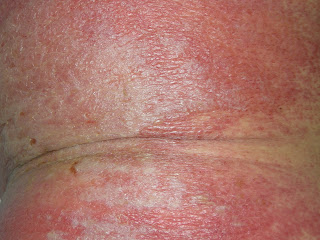Presented by Dr. Henry Foong,
Ipoh, Malaysia
Abstract: 41 yo man with short history of toxic erythema
HPI: The patient is a 41 yr old restaurant worker who presented with 5 day history of bilateral and symmetrical erythema over the loins, groins and knees.
About a week ago, he had a furunculosis on upper back and was prescribed Augmentin. Two days later he developed high fever and was treated with ciprofloxacin by a physician. A day later he noticed itchy rashes on both thighs and since then, the macular erythema spread symmetrically to the loins, upper shoulders and knees. He has no fever.
His past medical history was non-contributory.
Examination showed bilateral and symmetrical diffuse erythema on the thighs, knees, loins and upper shoulders. Over the loins, there was symmetrical and bilateral edematous areas with vesicles over a background of erythema. His scalp, oral cavity and genitalia were clear.
Clinical Photos:
Lab: Culture and a skin biopsy has been done. Culture negative. Biopsy pending. TWBC 3200 (N 85.1% L 10.3% E0 .5% M3.4% B 0.8%) ESR 36
Diagnosis: Toxic erythema
Differentials: Streptococcal/Staph cellulitis
Questions and Comments: The presence of blisters /edema on the loin is worrying. In the meantime what would you recommend for this patient? Would you use corticosteroids in this patient? I have stopped both augmentin and ciprofloxacin. In terms of dressing, I used wet compress with dil. KMNO4.Have I missed anything?
References:
1. Miyahara A, et. al. A new proposal for a clinical-oriented subclassification of baboon syndrome and a review of baboon syndrome. Asian Pac J Allergy Immunol. 2011 Jun;29(2):150-60
Source: Department of Pediatrics, Tokyo Medical University. miyahara.pediatrics@gmail.com
Abstract
OBJECTIVE: To review baboon syndrome (BS). Data Sources: Date sources were obtained from PubMed and Google Scholar: Photographs of baboon syndrome were obtained from our patient.
STUDY SELECTIONS: PubMed and Google Scholar were searched up to June 30, 2010. The search terms were "baboon syndrome", "SDRIFE" and "thimerosal allergy". Reverse references from relevant articles and Google Scholar were also used. As BS is a classical disease and cases of offending agents were relatively old, some references were more than five years old. In order to gather as many cases of offending agents as possible, more than 50 references were collected.
RESULTS AND CONCLUSION: We divided BS into as 4 groups; classical baboon syndrome, topical drug-induced baboon syndrome, systemic drug-induced baboon syndrome and symmetrical drug-related intertriginous and flexural exanthema (SDRIFE). The pathomechanism of BS is still unknown. A delayed type of hypersensitivity reaction, a recall phenomenon, pharmacologic interaction with immune-receptors and anatomical factors may be involved in the causation of BS. This valuable article is available in Free full text
2. Tan SC, Tan JW. Symmetrical drug-related intertriginous and flexural exanthema. Curr Opin Allergy Clin Immunol. 2011 Aug;11(4):313-8.
Department of Rheumatology, Allergy and Immunology, Tan Tock Seng Hospital, Singapore, Singapore. Sze_Chin_Tan@ttsh.com.sg
Abstract
PURPOSE OF REVIEW: Symmetrical drug-related intertriginous and flexural exanthema (SDRIFE), previously termed drug-related baboon syndrome, is a benign and self-limiting type IV hypersensitivity reaction characterized by symmetrical erythema involving the gluteal and intertriginous areas in the absence of systemic involvement. It may also occur in the absence of previous drug exposure.
RECENT FINDINGS: Antibiotics, in particular beta-lactams, comprise the majority of causes of SDRIFE. Other drugs which have been implicated include antihypertensives, radiocontrast media, chemotherapeutic agents, and biologics. Histology of lesional skin is variable with predominance of superficial perivascular inflammatory cell infiltrates. Outcomes of allergy tests are variable with positive delayed intradermal tests reported for penicillin V, allopurinol; positive patch tests for erythromycin, mitomycin, nystatin, pseudoephdrine; positive lymphocyte transformation tests for erythromycin; and positive drug provocation tests for clindamycin, cimetidine, corticosteroids, terbinafine, and valacyclovir.
SUMMARY: Diagnosis of SDRIFE is dependent upon recognition of the clinical morphology and distribution of the rash, and its temporal relationship to the use of the suspected drug. Outcomes of in-vivo and in-vitro tests have been inconsistent, and thus may not be useful in the identification of the putative drug.
























